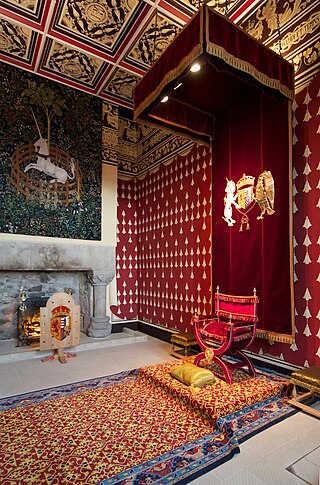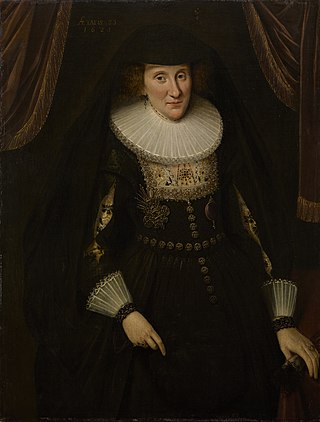
Anne of Denmark was the wife of King James VI and I. She was Queen of Scotland from their marriage on 20 August 1589 and Queen of England and Ireland from the union of the Scottish and English crowns on 24 March 1603 until her death in 1619.

Robert Bruce Stuart, Duke of Kintyre and Lorne was the fifth child of James VI of Scotland and Anne of Denmark. He was born at Dunfermline Palace, Fife. On 2 May 1602 he was created Duke of Kintyre and Lorne, Marquess of Wigton, Earl of Carrick and Lord of Annandale. He died at Dunfermline Palace on 27 May 1602 and was buried at Holyrood Abbey.

Dunfermline Palace is a ruined former Scottish royal palace and important tourist attraction in Dunfermline, Fife, Scotland. It is currently, along with other buildings of the adjacent Dunfermline Abbey, under the care of Historic Environment Scotland as a scheduled monument.

John Erskine, 2nd Earl of Mar was a Scottish politician, the only son of another John Erskine and Annabella Murray. He is regarded as both the 19th earl and the 2nd earl.

George Home, 1st Earl of Dunbar, KG, PC was, in the last decade of his life, the most prominent and most influential Scotsman in England. His work lay in the King's Household and in the control of the State Affairs of Scotland and he was the King's chief Scottish advisor. With the full backing and trust of King James he travelled regularly from London to Edinburgh via Berwick-upon-Tweed.
Jean Ker, Countess of Roxburghe, néeDrummond (c.1585–1643) was a Scottish courtier, serving Anne of Denmark in Scotland and England.
Patrick Gray, 6th Lord Gray, known most of his life as Patrick, Master of Gray, was a Scottish nobleman and politician during the reigns of Mary, Queen of Scots and James VI of Scotland.
Katherine Bellenden was a courtier working in the wardrobe of James V of Scotland. Her niece of the same name was similarly employed.

Sir Peter Young (1544–1628) was a Scottish diplomat, Master Almoner, and tutor to James VI of Scotland.

Margaret Stuart was the second daughter of King James VI of Scotland and Anne of Denmark. Sometime in March 1600, Margaret died of an unknown illness and she was buried in Holyrood Abbey. Three years later, her father ascended the throne of England.
Annabell Murray, Countess of Mar (1536–1603), was a Scottish landowner, courtier and royal servant, the keeper of the infant James VI and his son Prince Henry at Stirling Castle

The masque at the baptism of Prince Henry was a celebration at the christening of Prince Henry at Stirling Castle, written by the Scottish poet William Fowler and Patrick Leslie, 1st Lord Lindores.
Elizabeth or Elspeth Gibb was a Scottish courtier.

Anna Hay, Countess of Winton (1592-1628) was a Scottish courtier.

Alexander Miller or Millar (1559-1616) was an Edinburgh tailor who served James VI and I.

Peter Sanderson was an Edinburgh tailor who worked for Anne of Denmark wife of James VI of Scotland.

Margaret Seton, Lady Paisley was a Scottish aristocrat, courtier and a favourite of Anne of Denmark.
Catherine Murray was a Scottish aristocrat and courtier.
John Provand was a Scottish merchant in 16th-century Edinburgh.

Helen Littil was a Scottish courtier, the nurse of King James VI and I.













